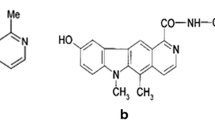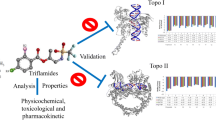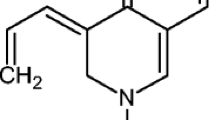Abstract
Topoisomerase inhibitors are used as anticancer and antibacterial agents. A series of novel 2,4,6-tri-substituted pyridine derivatives reported as topoisomerase inhibitors were used for quantitative structure–activity relationship (QSAR) study. In order to understand the structural requirement of these topoisomerase inhibitors, a ligand-based pharmacophore and atom-based 3D-QSAR model have been developed. A five-point pharmacophore with one hydrophobic group (H4), four aromatic rings (R5, R6, R7 and R8) was obtained. The pharmacophore hypothesis yielded a 3D-QSAR model with good partial least-square (PLS) statistic results. The training set correlation is characterized by PLS factors (r 2 = 0.7892, SD = 0.2948, F = 49.9, P = 1.379). The test set correlation is characterized by PLS factors (q 2 = 0.7776, root mean squared error = 0.2764, Pearson R = 0.8926). The docking study revealed the binding orientations of these inhibitors at active site amino acid residues of topoisomerases enzyme. The results of pharmacophore hypothesis and 3D-QSAR provided the detail structural insights as well as highlighted the important binding features of novel 2,4,6-tri-substituted pyridine derivatives and can be developed as potent topoisomerase inhibitors.

Key structural requirement for topoisomerase activity





Similar content being viewed by others
References
Wang JC (2002) Cellular roles of DNA topoisomerases: a molecular perspective. Nat Rev Mol Cell Biol 3:430–440
Wang JC (1996) DNA topoisomerases. Annu Rev Biochem 65:635–692
Boege F (1996) Analysis of eukaryotic DNA topoisomerases and topoisomerase-directed drug effects. Eur J Clin Biochem 34:873–888
Meriono A, Madden KR, Lane WS, Champoux JJ, Reinberg D (1993) DNA topoisomerase I is involved in both repression and activation of transcription. Nature 365:227–232
Kretzschmar M, Meisterernst M, Roeder R (1993) Identification of human DNA topoisomerase I as a cofactor for activator-dependent transcription by RNA polymerase II. Proc Natl Acad Sci USA 90:11508–11512
Zhang H, Wang JC, Liu LF (1988) Involvement of DNA topoisomerase I in transcription of human ribosomal RNA genes. Proc Natl Acad Sci USA 85:1060–1064
Lim M, Liu LF, Jacobson KD, Williams JR (1986) Induction of sister chromatid exchanges by inhibitors of topoisomerases. Cell Biol Toxicol 2:485–494
Shuman S (1991) Recombination mediated by vaccinia virus DNA topoisomerase I in Escherichia coli is sequence specific. Proc Natl Acad Sci USA 88:10104–10108
Yeh YC, Liu HF, Elis CA, Lu AL (1994) Mammalian topoisomerase I has base mismatch nicking activity. J Biol Chem 269:15498–15504
Stevnsner T, Bohr VA (1993) Studies on the role of topoisomerases in general, gene- and strand-specific DNA repair. Carcinogenesis 14:1841–1850
Nitiss JL (1994) Roles of DNA topoisomerases in chromosomal replication and segregation. Adv Pharmacol 29:103–134
Earnshaw WC, Mackay AM (1994) Role of non-histone proteins in the chromosomal events of mitosis. FASEB J 8:947–956
Eamshaw W, Heck M (1985) Localization of topoisomerase II in mitotic chromosomes. J Cell Biol 100:1716–1725
Earnshaw W, Halligan B, Cooke C, Heck M, Liu L (1985) Topoisomerase II is a structural component of mitotic chromosome scaffold. J Cell Bio 100:1706–1715
Holden JA (2001) DNA topoisomerases as anticancer drug targets: from the laboratory to the clinic. Curr Med Chem Anticancer Agents 1:1–25
Yu CX, Tse-Dinh YC, Fesik SW (1995) Solution structure of the C-terminal single-stranded DNA-binding domain of E. coli topoisomerase I. Biochemistry 34:7622–7628
Hooper DC (1998) Bacterial topoisomerases, anti-topoisomerases, and anti topoisomerase resistance. Clinical Infectious Diseases 27:S54–S63
Thapa P, Karki R, Choi H, Cho JH, Lee ES (2010) Synthesis of 2-(thienyl-2-yl or -3-yl)-4-furyl-6-aryl pyridine derivatives and evaluation of their topoisomerase I and II inhibitory activity, cytotoxicity, and structure–activity relationship. Bioorg Med Chem 18:2245–2254
Basnet A, Thapa P, Karki R, Choi H, Choi JH, Lee ES et al (2010) 2,6-Dithienyl-4-furyl pyridines: synthesis, topoisomerase I and II inhibition, cytotoxicity, structure–activity relationship, and docking study. Bioorg Med Chem Lett 20:42–47
Thapa P, Karki R, Thapa U, Yurngdong J, Lee ES et al (2010) 2-Thienyl-4-furyl-6-aryl pyridine derivatives: Synthesis, topoisomerase I and II inhibitory activity, cytotoxicity, and structure–activity relationship study. Bioorg Med Chem 18:377–386
Karki R, Thapa P, Kang MJ, Tae Cheon Jeong J, Namb M, Lee ES et al (2010) Synthesis, topoisomerase I and II inhibitory activity, cytotoxicity, and structure–activity relationship study of hydroxylated 2,4-diphenyl-6-aryl pyridines. Bioorg Med Chem 18:3066–3077
Basnet A, Thapa P, Karki R, Lee CS, Lee ES et al (2007) 2,4,6-Trisubstituted pyridines: synthesis, topoisomerase I and II inhibitory activity, cytotoxicity, and structure–activity relationship. Bioorg Med Chem 15:4351–4359
Kubinyi H (1997) QSAR and 3D QSAR in drug design part 1 methodology. Research focus 2:457–466
Schrödinger, LLC (2008) PHASE, version 3.0. Schrödinger, New York
Dixon SL, Smondyrev AM, Knoll EH, Rao SN, Shaw DE, Friesner RA (2006) PHASE: a new engine for pharmacophore perception, 3D QSAR model development, and 3D database screening: 1. Methodology and preliminary results. J Comput Aided Mol Des 20:647–671
Golbraikh A, Shen M, Xiao Z, Xiao YD, Lee K-H, Tropsha A (2003) Rational selection of training and test sets for the development of validated QSAR models. J Comput Aided Mol Des 17:241–253
Schrödinger, LLC (2008) Maestro, version 8.5. Schrödinger, New York
Chang G, Guida WC, Still WC (1989) An internal-coordinate Monte Carlo method for searching conformational space. J Am Chem Soc 111:4379–4386
Schrödinger, LLC (2008) Glide, version 5.0. Schrödinger, New York
FriesnerA RA, Banks JL, Murphy RB, Halgren TA, Klicic JJ, Mainz DT, Repasky MP, Knoll EH, Shelley M, Perry JK, Shaw DE, Francis P, Shenkin PS (2004) Glide: a new approach for rapid, accurate docking and scoring. 1. Method and assessment of docking accuracy. J Med Chem 47:1739–1749
Halgren TA, Murphy RB, Friesner RA, Beard HS, Frye LL, Pollard WT, Banks JL (2004) Glide: a new approach for rapid, accurate docking and scoring. 2. Enrichment factors in database screening. J Med Chem 47:1750–1759
Shah UA, Deokar HS, Kadam SS, Kulkarni VM (2010) Pharmacophore generation and atom-based 3D-QSAR of novel 2-(4-methylsulfonylphenyl)pyrimidines as COX-2 inhibitors. Mol Divers 14:559–568
Acknowledgments
The authors gratefully acknowledge the contributions of Prof. M. N. Navale, President, and Dr. (Mrs.) S. M. Navale, Secretary, Sinhgad Technical Education Society, Pune for constant motivation and encouragement.
Author information
Authors and Affiliations
Corresponding author
Rights and permissions
About this article
Cite this article
Kathiravan, M.K., Khilare, M.M., Chothe, A.S. et al. Design and development of topoisomerase inhibitors using molecular modelling studies. J Chem Biol 6, 25–36 (2013). https://doi.org/10.1007/s12154-012-0079-9
Received:
Accepted:
Published:
Issue Date:
DOI: https://doi.org/10.1007/s12154-012-0079-9




